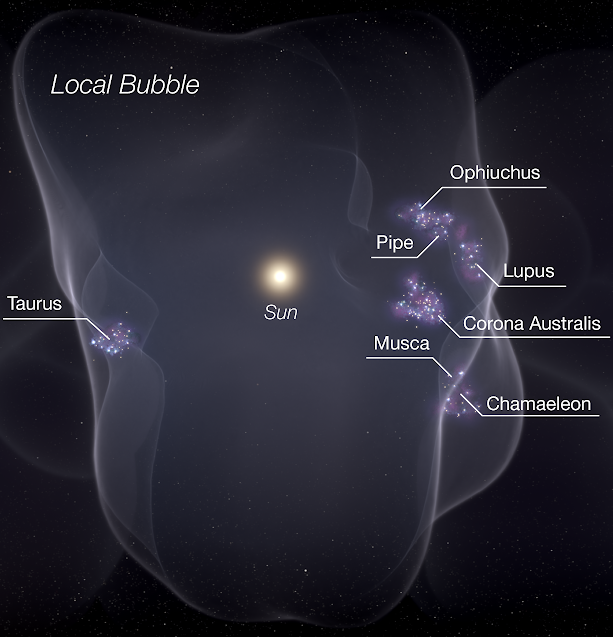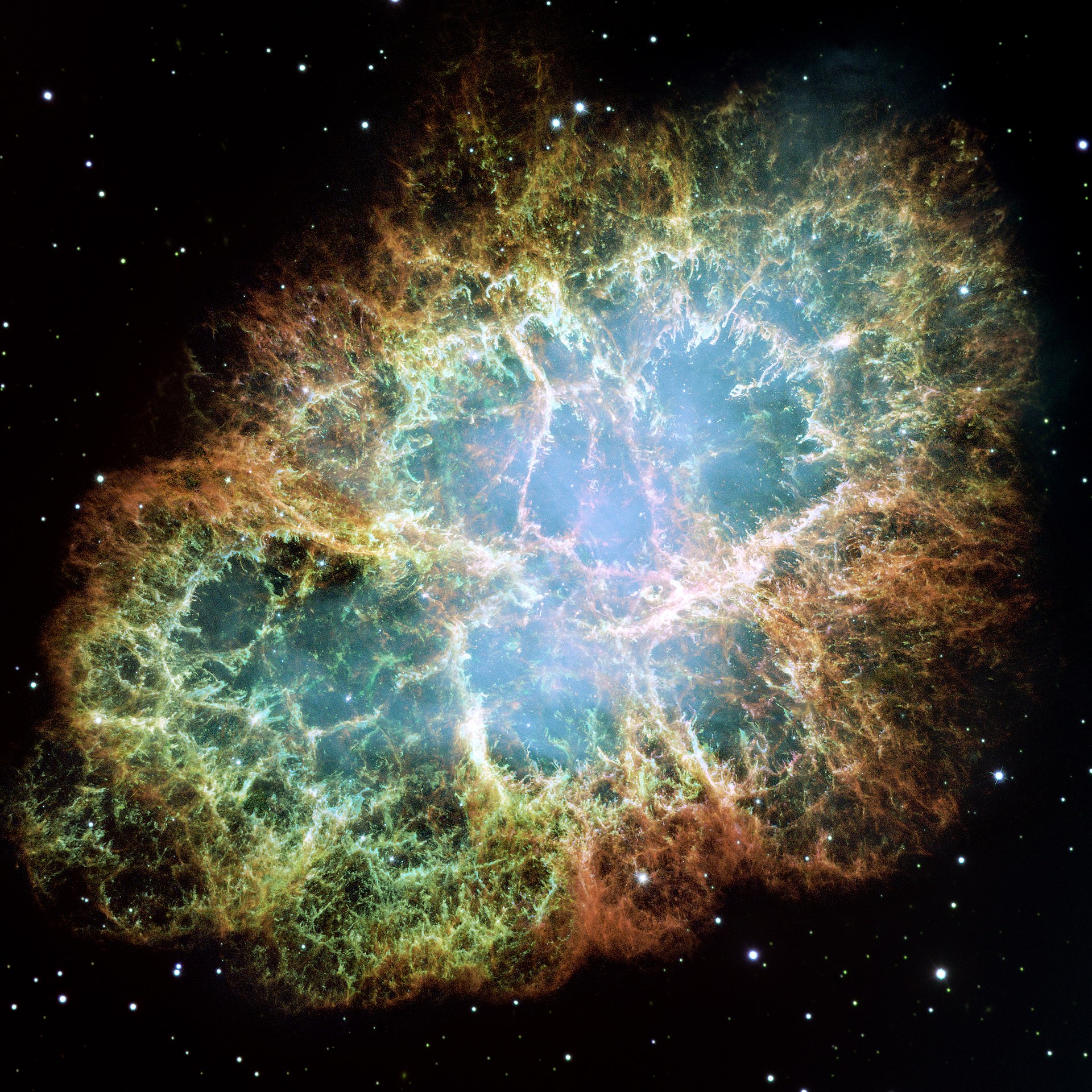I’ve seen several articles commenting the fact that for the last 5 MY or so, the solar system has been traversing the so called “local bubble“: The obvious explanation of this structure is a supernova remnant, something similar to the Crab nebula, only bigger; orders of magnitude bigger, in fact:
The obvious explanation of this structure is a supernova remnant, something similar to the Crab nebula, only bigger; orders of magnitude bigger, in fact:
The thing I personally find puzzling is that absolutely nobody mentioned the first thing that crossed my mind when I found out about this. You see, when you see a structure that has a stellar nursery on its gaseous outer perimeter, and empty space inside the perimeter, the first thing that comes to mind is to expect at least one black hole somewhere in the center of this structure; more precisely, there have probably been several supernovae of the population 2 stars in the center of this, and considering how big the structure is, I would expect them to have produced black holes, rather than neutron stars, and we are going right through this area.
Is this a danger? That’s hard to tell, but a black hole is not more dangerous than an ordinary star of its mass; it doesn’t just go around and suck things in. You need to get fairly close, and then the most likely outcome would be the disruption of the Oort cloud, with the likely result of multiple intrusions of comets into the inner solar system, and in the worst case, if we pass really close, it can disrupt the solar system, or cause the Sun to start misbehaving quite dramatically due to tidal effects, which could create extreme coronal mass ejections. As I said, it’s hard to tell – it all depends on how close we are to something we won’t necessarily even see unless we get dangerously close; if you can see it producing relativistic distortions of space on the night sky, you are basically fucked. It’s a very old black hole, and probably not of the kind that advertises itself by chewing up new matter and producing lots of radiation along its axis of rotation, or we would have seen it on a radio telescope by now. What is basically certain is that there is at least one, it is expected to be around the center of the local bubble, and we are basically there.
However, considering how big this structure is, we could miss it by a parsec or so, which is the distance to Alpha Centauri, and relative to this structure’s size I would still say we’re basically right on top of it, and it wouldn’t affect us at all, so it is what it is.


A week ago ESA’s Gaia mission published a press release as they discovered two new “invisible” black holes in our neighbourhood: https://www.esa.int/Science_Exploration/Space_Science/Gaia/Gaia_discovers_a_new_family_of_black_holes
Closer one is 1560 light years away in Ophiuchus which can be seen in the illustration of local bubble in your post above. Both are closest black holes discovered to date; previously the closest one was V616 Mon, about 3k light years away.
Gaia satellite is located at Lagrange 2 (shielded from the Sun by Earth, same as the James Webb telescope) and it’s able to precisely track star trajectories, which is used to detect otherwise invisible gravitational masses. It’s currently the only mission that could shed some light on this subject. Next big data release from Gaia is scheduled for end of 2025, so unless they find something new in existing data we probably won’t find know more before then.
I fell into a bit of rabbit hole researching this today. It seems that local bubble is part of tube-like “chimney” that is a few million years old. Local bubble was first thought to be a result from a single supernova whose remnant is Geminga, a pulsar in Gemini constellation, but now multiple supernovae from Pleiades moving group are considered responsible: https://arxiv.org/abs/astro-ph/0205128
There are two structures that form the Gould Belt that spans the Local Bubble; a sinusoidal gas structure 9000 light years long on one side of the Local Bubble, and the Split on another side. Astronomers traced both of them back in time, and about 20 million years ago they were roughly at the same place, which triggered star formation and supernovae in Pleiades that formed the Local Bubble.
Instead of a single black hole, there were allegedly about 20 supernovae in Pleiades over the past 10-20M years as they moved through the area that is currently the Local Bubble. Pleiades is in Taurus which is drawn in illustration of the Local Bubble in the post above, currently about 440 light years from the Sun, and moving away from us at a speed of 5.7 km/s.
So, if there is something massive lurking in the darkness, Gaia mission might be able to uncover it; arguably, it should have already uncovered it if it’s dangerously close, but we can’t know for sure.
As for other dangers, we have been lucky to avoid cosmic radiation and gas as we have been moving through Local Bubble. In about 50k years, denser part of Local Interstellar Cloud or so-called “Local Fluff” is about to reach Solar heliosphere and irradiate Earth. Then the Solar system is due for collision with Andromeda in 4.5 billion years, and finally, Sun will expand and engulf Earth in about 5 billion years. All of that is too far in the future to be relevant to humans.
There’s a nice projection of this stuff here: https://faun.rc.fas.harvard.edu/czucker/Paper_Figures/Interactive_Figure1.html
https://www.youtube.com/watch?v=08UlpJBt5Ic
A week ago ESA’s Gaia mission published a press release as they discovered two new “invisible” black holes in our neighbourhood: https://www.esa.int/Science_Exploration/Space_Science/Gaia/Gaia_discovers_a_new_family_of_black_holes
Closer one is 1560 light years away in Ophiuchus which can be seen in the illustration of local bubble in your post above. Both are closest black holes discovered to date; previously the closest one was V616 Mon, about 3k light years away.
Gaia satellite is located at Lagrange 2 (shielded from the Sun by Earth, same as the James Webb telescope) and it’s able to precisely track star trajectories, which is used to detect otherwise invisible gravitational masses. It’s currently the only mission that could shed some light on this subject. Next big data release from Gaia is scheduled for end of 2025, so unless they find something new in existing data we probably won’t find know more before then.
I fell into a bit of rabbit hole researching this today. It seems that local bubble is part of tube-like “chimney” that is a few million years old. Local bubble was first thought to be a result from a single supernova whose remnant is Geminga, a pulsar in Gemini constellation, but now multiple supernovae from Pleiades moving group are considered responsible: https://arxiv.org/abs/astro-ph/0205128
There are two structures that form the Gould Belt that spans the Local Bubble; a sinusoidal gas structure 9000 light years long on one side of the Local Bubble, and the Split on another side. Astronomers traced both of them back in time, and about 20 million years ago they were roughly at the same place, which triggered star formation and supernovae in Pleiades that formed the Local Bubble.
Instead of a single black hole, there were allegedly about 20 supernovae in Pleiades over the past 10-20M years as they moved through the area that is currently the Local Bubble. Pleiades is in Taurus which is drawn in illustration of the Local Bubble in the post above, currently about 440 light years from the Sun, and moving away from us at a speed of 5.7 km/s.
So, if there is something massive lurking in the darkness, Gaia mission might be able to uncover it; arguably, it should have already uncovered it if it’s dangerously close, but we can’t know for sure.
As for other dangers, we have been lucky to avoid cosmic radiation and gas as we have been moving through Local Bubble. In about 50k years, denser part of Local Interstellar Cloud or so-called “Local Fluff” is about to reach Solar heliosphere and irradiate Earth. Then the Solar system is due for collision with Andromeda in 4.5 billion years, and finally, Sun will expand and engulf Earth in about 5 billion years. All of that is too far in the future to be relevant to humans.
There’s a nice projection of this stuff here: https://faun.rc.fas.harvard.edu/czucker/Paper_Figures/Interactive_Figure1.html
https://www.youtube.com/watch?v=08UlpJBt5Ic
As I said, I don’t know if it’s of any immediate importance, but it’s one of many things I like to be aware of, regardless.